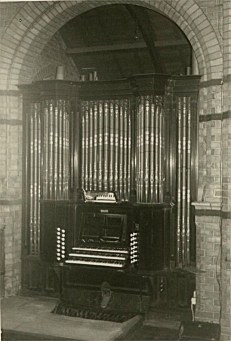formerly in
St.Luke's Church, Winterton Hospital, Sedgefield, Co.Durham
[now at Brancepeth Parish Church]


|
Winterton Hospital Although there was a proposal to establish a County Asylum as early as 1827, nothing materialised until the middle of the century when building was started by the County Justices under the provisions of the 1808 and 1853 Pauper Lunatic Acts. The original site of 52 acres was purchased in 1855. The first buildings were erected to designs of John Howison, the County Architect, at a cost of £50,000, and the Asylum opened on the 13th April 1858. New buildings, including the Winterton wing, after which the whole hospital came to be named, were erected in 1879 and 1889 to the design of Wm.Crozier, County Architect. The site and grounds, including a farm, then covered about 350 acres. Until the 1990's Winterton
was a large psychiatric hospital, at its height involving some 3000
people - residents and day patients and staff - serving as a local centre
for the south Durham area, and for the specialist psychiatric care needs
of much of County Durham and beyond. Current thinking has moved to
"care in the community", and large residential institutions like Winterton
Hospital have been closed, and are now being redeveloped for other uses
- in this case for housing and NetPark,
a technology park. The Church is listed, so should not be demolished, but
is now intended to be used as a Nurseryin conjunction with surrounding
developments.
St.Luke's Church
"Services are regularly held in the new Chapel. A very efficient choir has been formed...to which Dr. Smith as choirmaster devotes much time and pains. The services are a great delight and comfort to the patients. As a rule every seat is occupied and yet the services are perfectly orderly and free from disturbance. Moreover in 1888: "Music is at a pitch which is the admiration of every visitor "[sic!]. Chapel facts: Length 125ft, Width 54ft, Height 48ft. Seating for 700.
The Organ
Henry Willis
(1821 - 1901) earned his epithet by being one of the greatest and best
of the Victorian organ-builders. His instruments reamin eminently versatile
and musical even by today's standards. Willis seldon "signed" organs with
his nameplate - he argued the instruments spoke for themselves. Though
in several ways by no means typical of the builder, the Winterton organ
is characteristic in terms of its excellent construction and workmanship.
It looks well, too, in its unusal diminutive "classical" case, with the
console placed between a downward continuation of the two towers, on which
the stop jambs are mounted. Though clearly not designed for the size of
this building, the quality of the pipework and voicing produces a splendid
singing tone and some exquisite individual registers.
Until the church closed, the organ was generally well looked after in
its 100+ year life at the hospital, though there was talk of replacing
it with "a modern electronic instrument" before the last restoration was
agreed to. Maintenance work was undertaken, apparently by the installers,
in 1896, 1899 and 1907. The local firm, Harrison
& Harrison of Durham, quoted unsuccessfully in 1907, but took over
responsibility at a cleaning in 1911 [£44]. Apart from regular tuning,
more specific work to clean and overhaul the instrument was carried out
in 1948 [£270], and 1965 [£1030]. With only minor exceptions
the Willis handiwork is unaltered. The Swell shutter operation was changed
from a ratchet pedal to a balanced system in 1948, whilst a Pedal stop
was changed and tuning slides were added in 1965. An electric blower replaced
the earlier hydraulic one, in the shallow cellar below the organ, probably
in 1927.
Organbuilders are not noted for being generous in their opinions of other builders' work, and so it is particularly interesting to read comments about this organ in another major firm's records: "....Mr.Harrison senior was a pupil of Mr.Henry Willis and knows his work very well....It would be a pity to allow so good an instrument to remain longer with defects...of ordinary wear and tear" (Letter of 10/7/1896).A number of organ experts and players have visited and tried the Winterton organ over the years and have been impressed with what they have found. For instance The Organ Club of Great Brtain visited the Durham area in 1979, and subsequently its Journal reported that "it would be hard to find two more contrasted organs by Father Willis than those at the Dominican Priory in Newcastle and Winterton Hospital. Most preferred the smaller and in some ways less typical one at Winterton". On another oaccasion, the then Organ Adviser to the diocese pronounced the diapasons some of the best he had heard for a long time. In 1994 when regular use was discontinued, the reed stops in particular
were a little "tired" and in need of attention, but otherwise, it remained
a fine enjoyable instrument, for players and audiences alike. The plans
to move the organ to Brancepeth Church, following the rescue and restoration
of the building structure following a devastating fire, have [in 2005]
been achieved. At Brancepeth the organ has a setting fully worthy of the
organ's special character and appearance and should continue to give good
service for many years to come.
Organ details
Richard Hird: Winterton Organist 1977 to 1995 Leaflet first produced June 1985; up-dated and revised
as webpage October 2002, and after the transfer to Brancepeth: May 2005
This organ has now been transferred to Brancepeth Parish Church, near Durham, where it is sited at the west end under the tower arch, and has been restored with the Pedal alterations reversed and a new matching Great Trumpet.
Organs Adviser || Cathedral organs || Recitals || Darlington Organists .
|